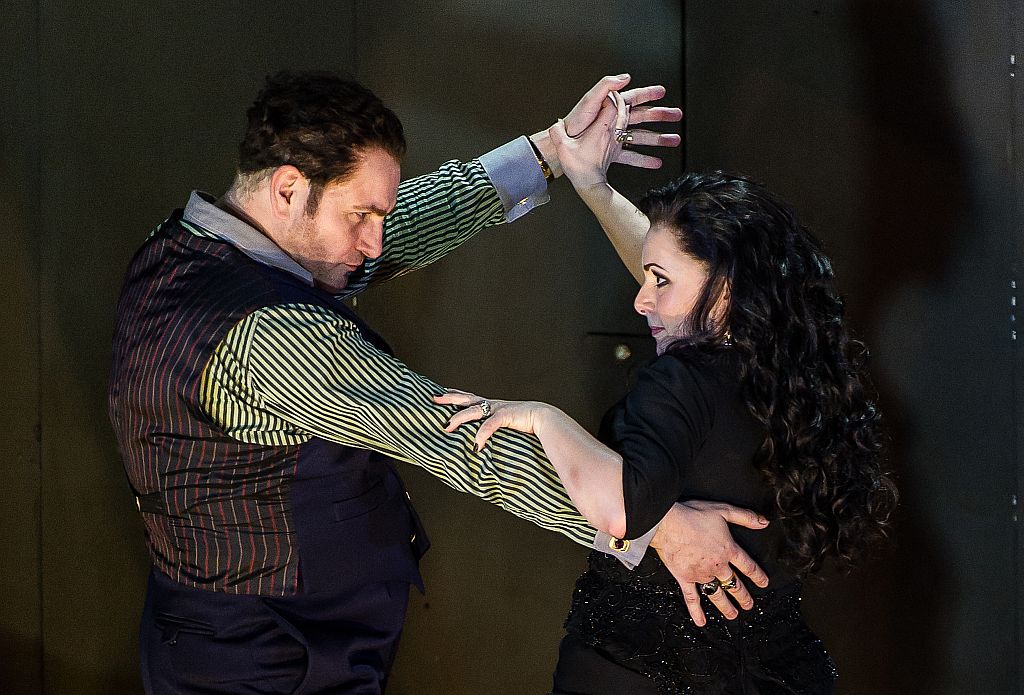Händel Rodelindája az Angol Nemzeti Operában. A 2014. márciusi előadásokról KŐRY ÁGNES írt beszámolót
Az Angol Nemzeti Opera (ENO) Rodelinda-produkciója két ellentétes tényezőből fonódott össze élvezetes élménnyé. Noha természetesen Händel nagyon is komoly operája állt a produkció középpontjában, ugyanakkor a színházi élmény nem csak élvezetes volt, de gyakran komikus is.
A Rodelinda (vagyis teljes címén Rodelinda, Regina de’ Longobardi) Händel harmadik operája a Julius Caesar és a Tamerlano után, amelynek premierje a londoni King’s Theatre-ben (Haymarket) volt az 1724/1725-ös szezonban. A mű az opera seria nagyszerű példája csodálatos zenével, továbbá drámai konfliktusokkal szerelem és hatalom, hűség és árulás, jó és gonosz között. A szövegkönyv cselekménye sok változáson ment át, kezdve egy VII. századi lombardiai történettel, folytatva Paul de Deacon Historia Langobardorum című művével (a 787-796 közötti időszakból), Pierre de Corneille Pertharite, roi des Lombards (1651) és Antonio Salvi Rodelinda, regina de’ Longobardi (1710) című drámáival, így érkezve Nicola Francesco Haym szövegkönyvéig. Viszont a szerelem és hűség győzelme a gonoszság felett a sok változás ellenére is megmaradt az alaptéma.
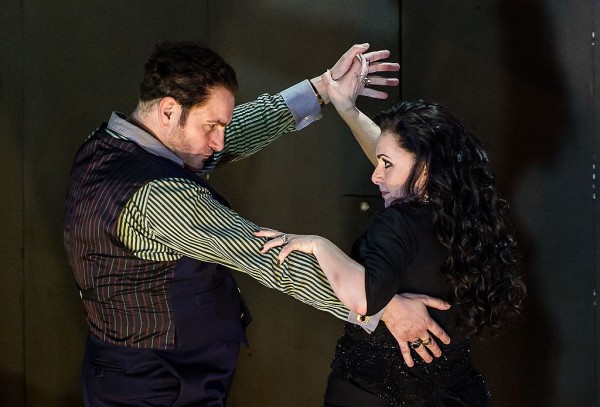
Haym és Händel változatában Grimoaldo elűzi a trónjáról Bertarido királyt. Bertarido külföldre menekül, de hátrahagyja lánytestvérét (Eduige), feleségét (Rodelinda) és kisfiát (Flavio). Bertarido hamis hírt terjeszt magáról, amely szerint meghalt. Rodelinda gyászolja, Grimoaldo pedig igyekszik megnyerni Rodelinda kezét. Emiatt Eduige, aki nagyon szeretne királynő lenni Grimoaldo hitveseként, nagyon dühös. Rodelindának nincs más választása, látszólag elfogadja Grimoaldo házassági ajánlatát. Ez viszont csalódottá teszi a még mindig álruhás Bertaridót, aki Rodelindat hűtlennek gondolja. Viszont a cselekmény néhány nem várt fordulata után kiderül, hogy Rodelinda sziklaszilárd Bertaridóhoz való hűségében, és a kegyetlen Garibaldo halálától eltekintve minden jól végződik: Grimoaldo visszaadja Bertaridónak királyságát, Bertarido pedig mindenki nagy örömére boldogan újraegyesül Rodelindával.
Jelen előadás rendezője, Richard Jones nyilvánvalóan nem bízik abban, hogy a szövegkönyvben foglalt történet hatásos lehet. Jones lényegesen megváltoztatja a néma kisgyermek, Flavio szerepét. Ebben a produkcióban Flavio nem ártatlan kisfiú, hanem nagyjából húszéves, továbbá állandó (és néhányszor kegyetlen) részvevője az eseményeknek. Az opera végén nyilvánvaló élvezettel és szadizmussal meggyilkolja Grimoaldót, pedig Haym szövege és Händel zenéje szerint a szereplők ekkor boldogan ünneplik a kibékülést, megbocsátást, továbbá a szeretet és a jóság győzelmét. Jones vélhetően azt kívánja hangsúlyozni, hogy ha egy kisgyerek kegyetlenség és ámítás közepette nő fel, szörnyeteggé válik. Ez lehetséges, de Haym és Händel operája másról szól.
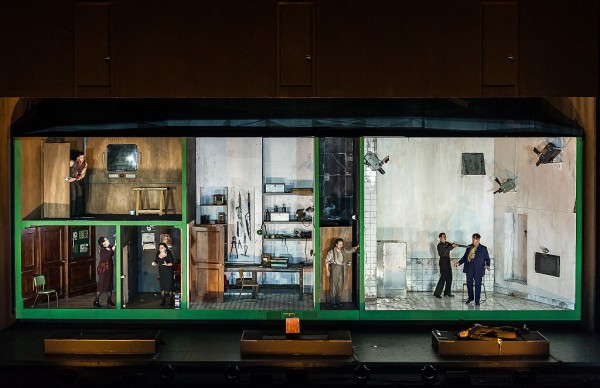
Händel korában a közönség többnyire azért ment operaelőadásokra, hogy hallhassa az énekeseket. Ez különösen érvényes lehetett a Rodelinda esetében, mert a szereplők között olyan sztárénekesek voltak, mint például az állítólag nagy és híres Senesino. Senki sem várta el az énekesektől, hogy maradandó színházi élményt nyújtsanak. A feladatuk az volt, hogy örömet okozzanak hangjukkal, virtuóz technikájukkal és valószínűleg muzikalitásukkal. Az énekesek a hangjukkal közvetítették a drámát. A mai közönség viszont teljes színházi élményt vár el az operaházban.
Richard Jones két módon oldja meg a problémát. Egyrészt gyakran engedi, hogy az énekesek csak álljanak és koncentrálhassanak nehéz, virtuóz szólamukra. Ugyanakkor a többi szereplő rohangál a színpadon, némajátékkal ábrázolnak, táncolnak stb. Ezekben a jelenetekben Jones aktiválja a színpadot, de nem zavarja Händel nehéz vokális szólamait. Másrészt Jones gyakran humort – még bohózatot is – kever a drámába, habár ilyesmi nem fordul elő se a szövegkönyvben, se a zenében.
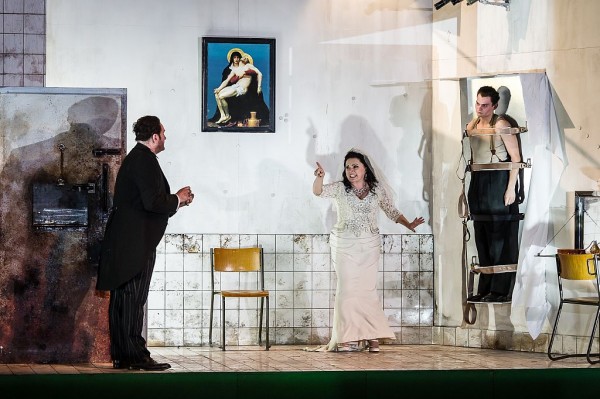
Azonban Jones metódusa szórakoztató színházat teremt. Én élveztem a színpadi előadást – vagyis majdnem, mert időnként a színpadi trükkök ízléstelenek voltak –, de a zenére való koncentrálásom időnként lankadt. Például egy virtuóz ária alatt két másik kiváló énekes mesteri módon táncolt egy stílusos, ízléses és csábító tangót. Nem tudtam levenni szememet a táncosokról (vagyis a nagynevű énekesekről), így tehát a lebilincselő áriából háttérzene lett.
Habár az opera cselekménye eredetileg a VII. századi Lombardiában játszódik, Jones és alkotótársai (Jeremy Herbert díszlet-, Nicky Gillibrand jelmez- és Mimi Jordan Sherrin világítástervező) a XX. századi fasiszta Olaszországba helyezik a történetet. A fő díszletelem egy nagy doboz, ami szobákra oszlik az előadás folyamán: legkevesebb két szobára, de időnként még hatra is. Egyidejűleg több szobában mozognak a szereplők, de az aktivitást gyakran fokozza az egyik szobából a másikba való rohanás. Mialatt a sok jövés-menést nézzük a színpadon, könnyű elfelejteni, hogy Händel egész szereplőgárdája hat énekesből és egy nem éneklő kisgyerekből áll. Vannak, akik Händel operáit unalmasnak találják. Elképzelhető, hogy Richard Jones az ellenkezőjét akarta bizonyítani.
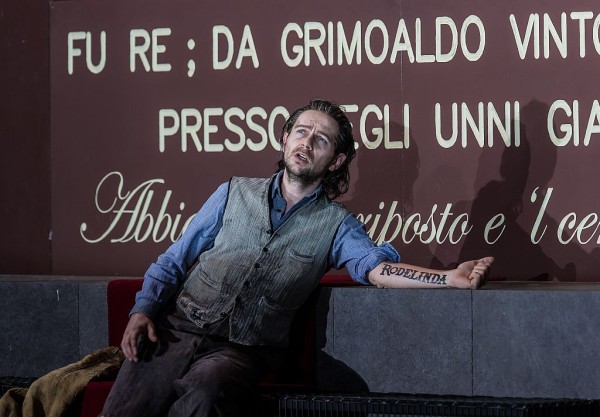
Zenei szempontból sok értékes része volt a produkciónak, a szereplők kivétel nélkül jó teljesítményt nyújtottak. Érdekes módon a sokat dicsért szoprán, Rebecca Evans (Rodelinda) néha sivító hangszínnel énekelt, máskor nem teljesen érthető kiejtéssel; de ezen túlmenően nem lehetett kritizálni. A második felvonás végi búcsúkettős (Evans és a Bertaridót éneklő Iestyn Davies kontratenor jóvoltából) mind zeneileg, mind a színpadtechnikát illetően döbbenetesre sikerült. Az énekeseket a lassan szétváló és ellenkező irányba sikló két színpadrész választotta el, mialatt Grimoaldo – aki Rodelinda és Bertarido elválasztását elrendelte – magányosan, egyedül maradt a színpad közepén. Daviest sokan dicsérték teljesítményéért, és jogosan. A másik kontratenor, Christopher Ainslie (Unulfo), szintén lélegzetelállító volt virtuozitásával (beleértve színpadi akrobatikus felkészültségét is!). Mélyebb hangja érdekes kontrasztot alkotott Davies inkább szopránszínű kontratenorjával. Zeneileg Ainslee elsőrangú. Csak dicsérni lehet a tenor John Mark Ainsley (Grimoaldo) magasrendű művészi teljesítményét, továbbá a mezzoszoprán Susan Bickley (Eduige) és a bariton Richard Burkhard (Garibaldo) produkcióját is – mindnyájan hűen szolgálták Händel csodálatos zenéjét. Matt Casey (a nem-éneklő, nem-beszélő Flavio) meggyőzően szolgálta Richard Jones koncepcióját, de ennek a beállításnak vélhetően se Haym, se Händel nem örült volna.
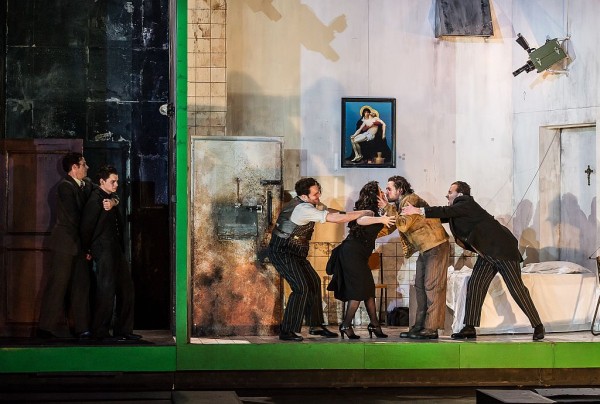
Christian Curnyn karmester kétségkívül ismeri Händel zenéjét. Vélhetően az ő érdeme, hogy a da capo áriák visszatéréskor valóban megváltoztak. Viszont Curnyn szeret gyorsabban vezényelni, mint szükséges, és kedveli a vidám hangulatot akkor is, amikor sötétebb színeket várnánk.
Nagyszerű zene és nagyszerű énekesek. Nem panaszkodhattunk.
Fotók: Clive Barda / English National Opera
Rodelinda, English National Opera, London, March 2014
The recent, highly successful run of Händel’s Rodelinda at the English National Opera seemed to have two opposing forces at play which, nevertheless, blended into a very enjoyable experience. On one hand we had Händel’s serious opera; on the other hand, the theatrical experience was not only entertaining but often even comic.
Rodelinda (or, with its full title, Rodelinda, Regina de’ Longobardi) is the third of three Händel operas (after Giulio Cesare and Tamerlano) which received their first performances at the King’s Theatre in the Haymarket during 1724 and 1725. It is opera seria at its best; with sublime music and a plot dramatising conflicts between love and power, fidelity and betrayal, good and evil. The story-line from seventh-century Lombard history underwent some changes from Paul de Deacon’s Historia Langobardorum (written between 787 and 796), through Pierre Corneille’s play Pertharite, roi des Lombards (1651) and Antonio Salvi’s Rodelinda, regina de’ Longobardi (1710), to the libretto of Nicola Francesco Haym. However, love and fidelity triumphing over evil remains the basic essence.
In the Haym/Händel version King Bertarido, ousted from power by Grimoaldo, flees abroad leaving behind his sister Eduige, his wife Rodelinda and their son Flavio. Bertarido circulates a false report about his own death which leaves Rodelinda mourning and the usurper Grimoaldo wooing her. This leaves Eduige, keen on becoming queen on Grimoaldo’s side, furious. Faced with some harsh choices, Rodelinda evidently agrees to marry Grimoaldo which makes Bertarido, still in disguise, disappointed about Rodelinda’s lack of fidelity. However, after some twists and turns, Rodelinda’s steadfast fidelity becomes clear and, with the exception of the death of cruel Garibaldo, all ends well. Grimoaldo restores the throne to Bertarido, who happily re-unites with his wife Rodelinda to the joys of all.
Stage director Richard Jones does not seem to trust the plot to make a sufficient impact. He makes a significant change with the non-singing role of the child Flavio. In Jones’ production he is not an innocent young child but about twenty years old and a constant (and at times cruel) participant of the action. On conclusion, he murders Grimoaldo with evident relish and sadism, yet at that point Hyam’s libretto and Händel’s music celebrate reconciliation, forgiveness, and the triumph of love and goodness. Presumably Jones makes the point that having grown up witnessing cruelty and deceit, Flavio becomes a monster. This may be, but it is not the Hyam/Händel conclusion.
In Händel’s time, more often than not, the prime motivation for audiences to attend the opera was to hear the singers. This was particularly true in the case of Rodelinda where the cast included star singers such as the evidently great and famous Senesino. The singers were not expected to turn out great theatrical experiences; their task was to delight with their voices, vocal virtuosity and presumably musicality. They delivered the drama with their voices. However, audiences of today expect a full theatrical experience in the opera house. Richard Jones’ solution to this problem is two-fold. On one hand he often allows his singers just to stand and focus on their demanding, virtuoso vocal lines while, at the same time, other protagonists in the plot do some running around the stage, miming, dancing and so on. In such scenes Jones creates stage business while not interfering with Händel’s demanding vocal lines. On the other hand, more often than not, Jones adds humour – even slapstick comedy – to the drama, although there are none either in the libretto or in the music. Nevertheless, Jones’ approach creates an entertaining piece of theatre. I thoroughly enjoyed the experience – well, almost: some of the stage business went over the top – but my attention to Händel’s music suffered from time to time. One example was a virtuoso solo aria, during which two other distinguished singers danced a very skilful, tasteful and seductive tango: I could not take my eyes off the dancers, which relegated the superb aria into background music.
Although the work’s original setting is seventh-century Lombardy, Jones and his designer team (Jeremy Herbert sets, Nicky Gillibrand costumes and Mimi Jordan Sherrin lighting) update the action to twentieth-century fascist Italy. The main set consists of a box which divides into various number of rooms throughout the opera; never less than two rooms but at times even six. There is simultaneous action in several rooms at the same time, but activity is also maintained by a lot of running from room to room. While watching all these comings and goings (including the non-singing Flavio’s histrionics) it is easy to forget that Händel’s entire cast consists of six singers and a non-singing child. There are people who think that Händel operas are boring. Has Richard Jones decided to disprove them?
Musically there was much to celebrate and cherish. Without exception, the cast was superb. Ironically, the only weakness (for these pair of ears) was soprano Rebecca Evans’ (Rodelinda) occasional shrill notes and slightly less than clear musical diction. However, much of her delivery was beyond any criticism. Her farewell duet with countertenor Iestyn Davies (Bertarido) at the end of Act 2 was breath-taking both in terms of musical delivery and stage craft. The two of them were separated by the set dividing into two and slowly gliding into opposite directions (with Grimoaldo, ordering the separation of Rodelinda and Bertarido, left alone in the middle of the stage lonely and desolate). Davies has been much praised for his performance and rightly so. The other countertenor in the cast, Christopher Ainslie (Unulfo) is also mind blowing with his virtuosity (as well as acrobatic skills on stage). His deeper voice provided an interesting contrast to the more soprano-like quality of Davies’ voice, and his musicality is second to none. One can only praise the superb artistry of tenor John Mark Ainsley (Grimoaldo), mezzo-soprano Susan Bickley (Eduige) and baritone Richard Burkhard (Garibaldo); all of them delivering every aspect of Händel’s glorious music. Matt Casey (non-singing, non-speaking Flavio) did an excellent job of Richard Jones’ concept, which arguably neither Haym nor Händel would have approved.
Without doubt, conductor Christian Curnyn knows his Händel. Presumably credits are due to him for making a genuine difference in the returning sections of all da capo arias throughout the performance. Nevertheless, Curnyn does have a tendency for faster (than necessary) speeds and for jovial mood when darker shades may be expected.
My final verdict? Glorious music and a cast to kill for. Thank you, ENO.
Photos: Clive Barda / English National Opera

